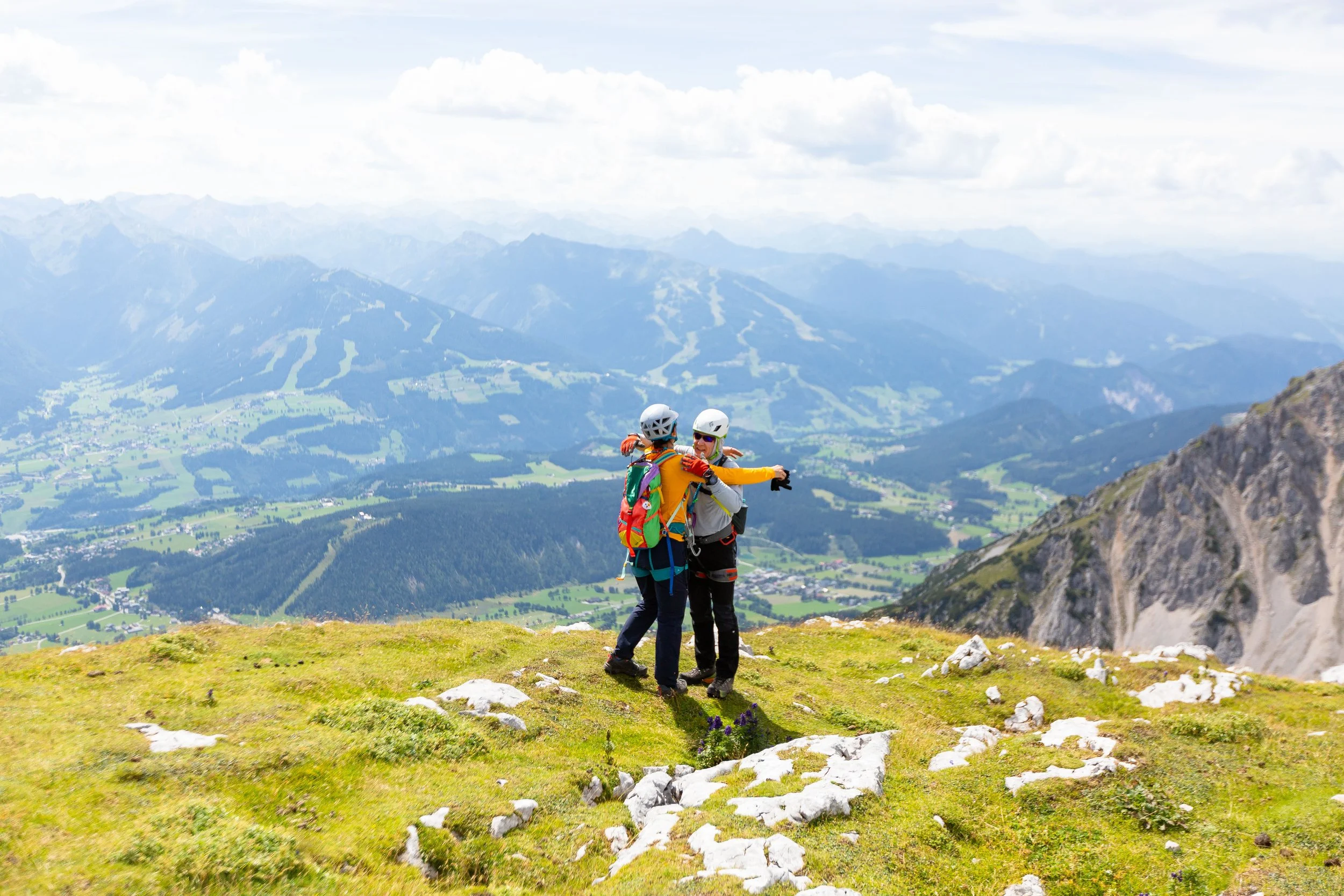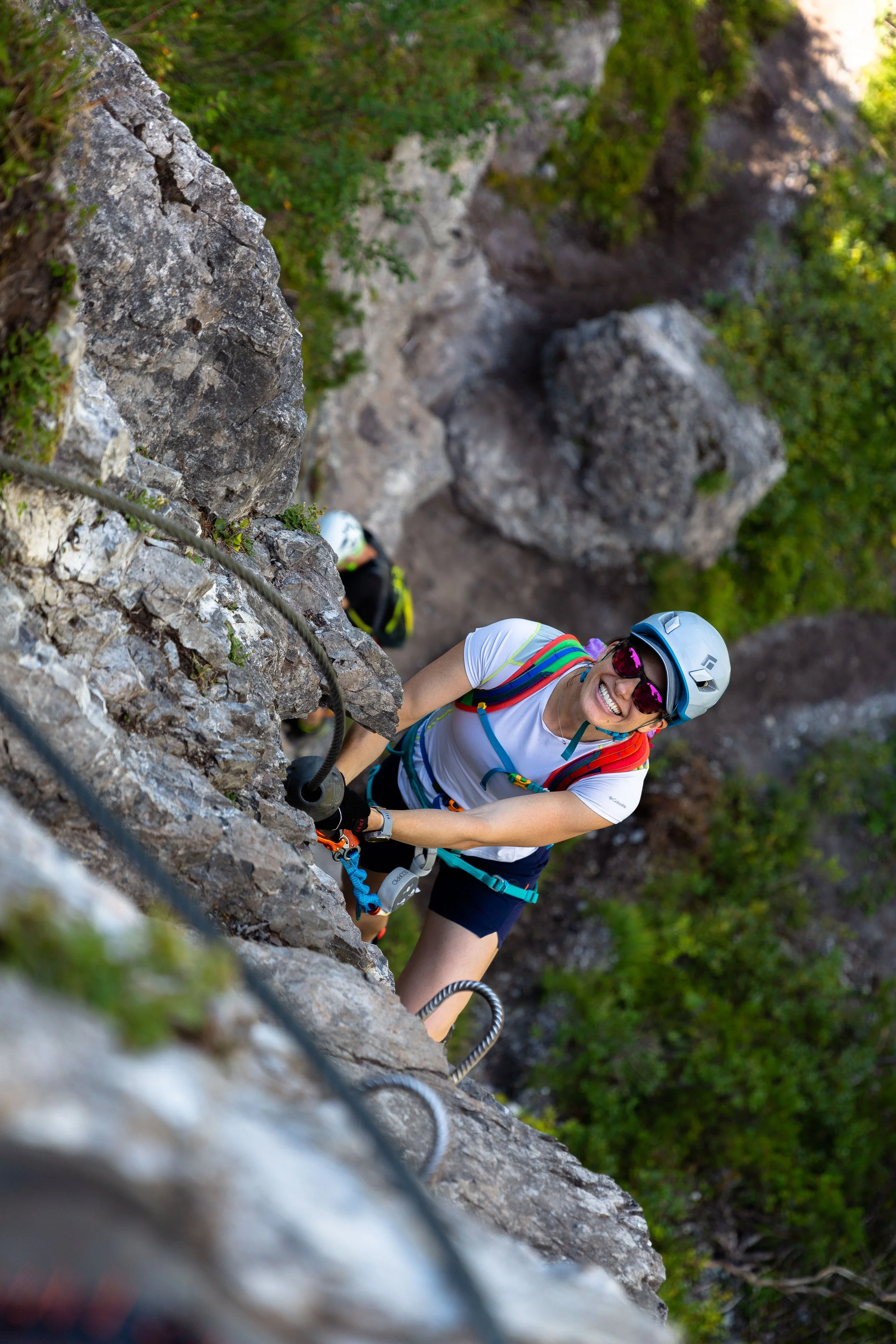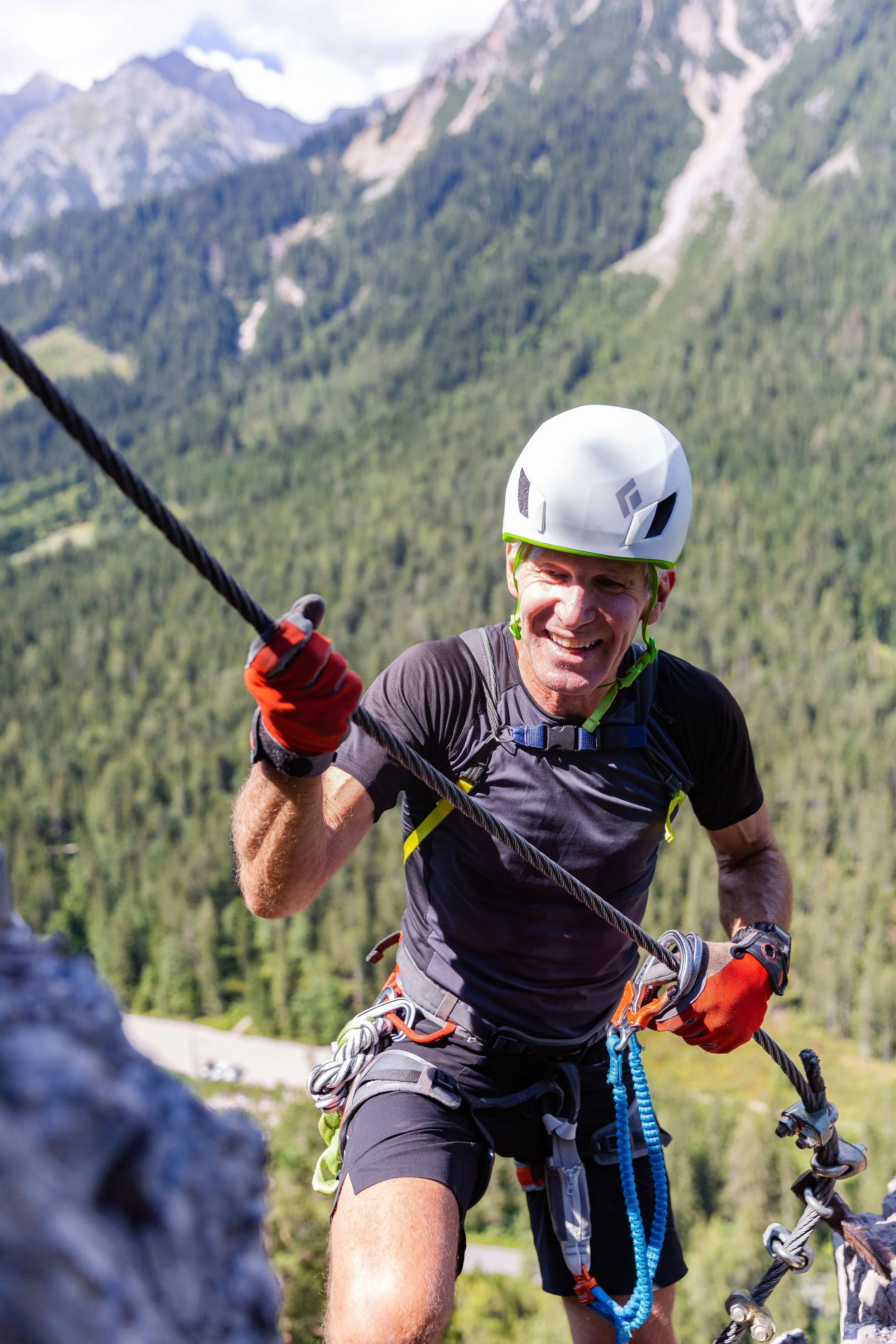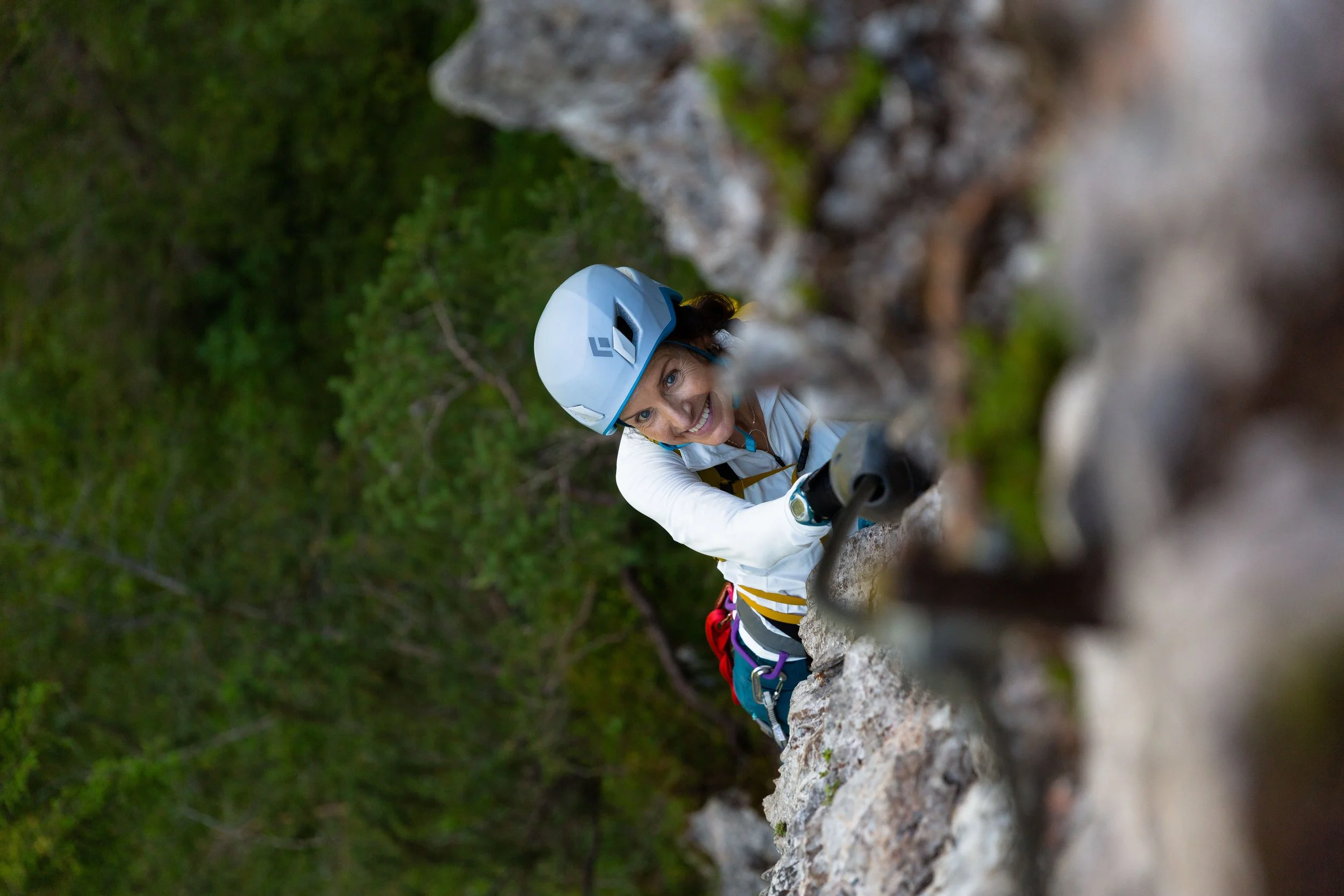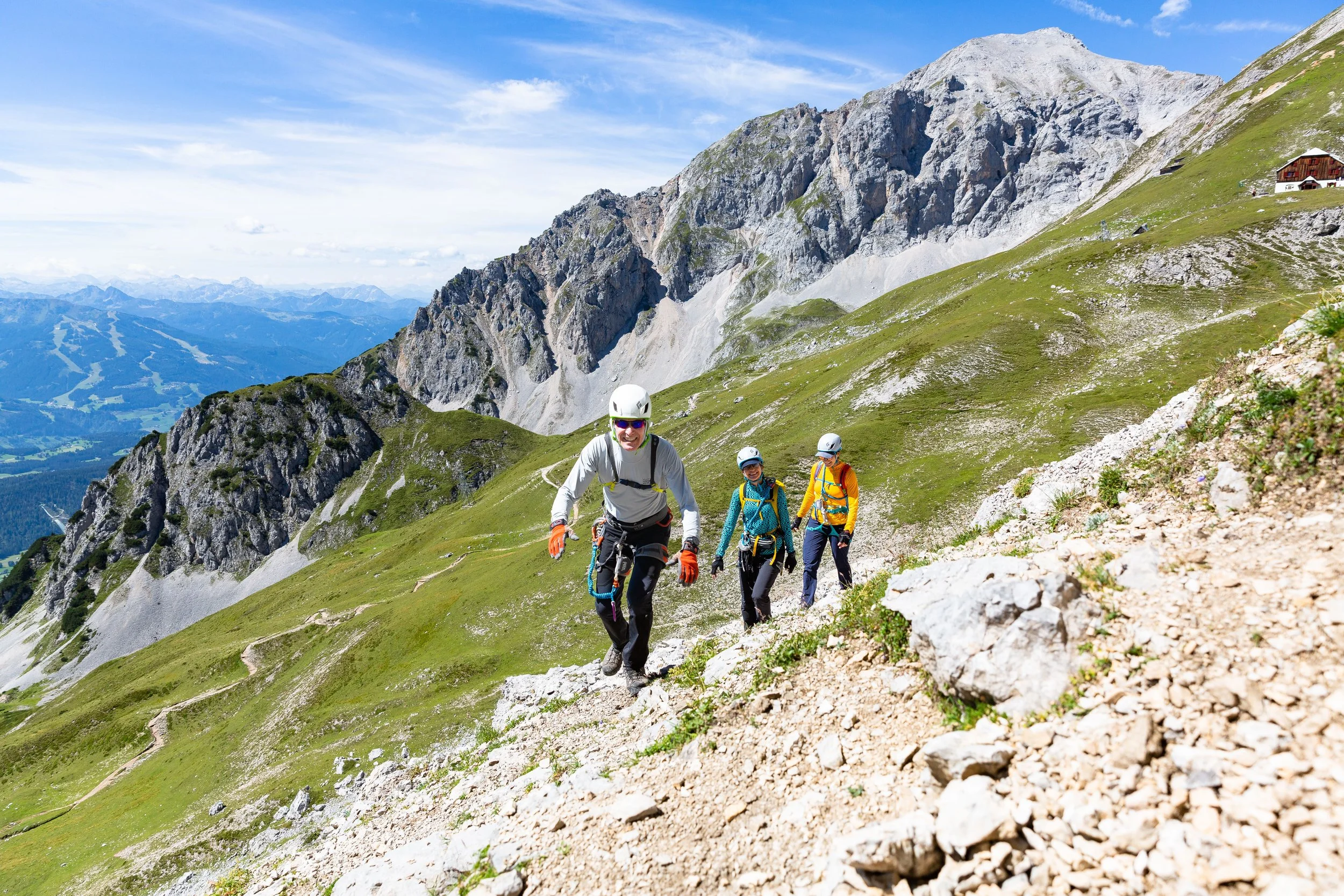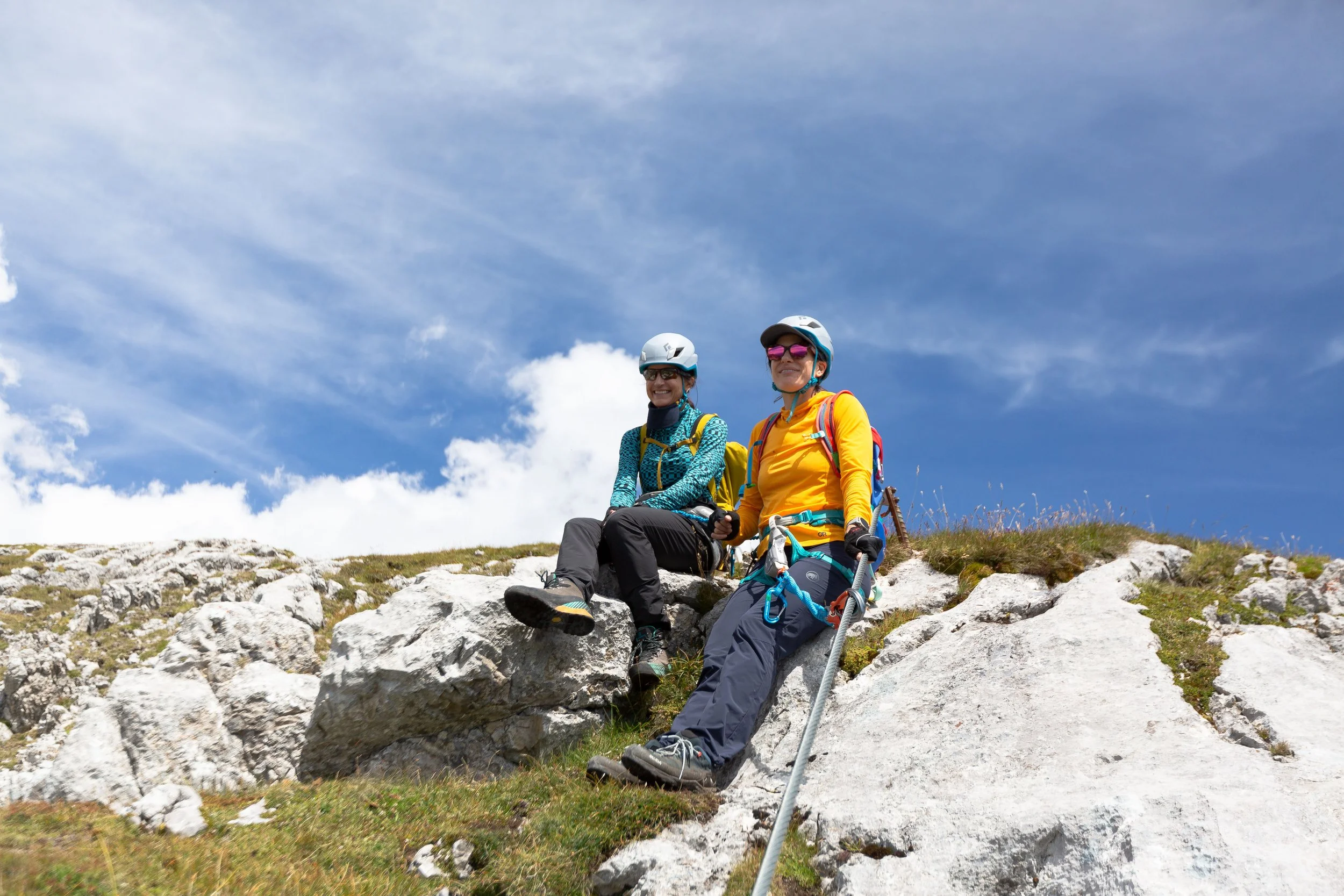Ramsau am Dachstein
Natalie’s father, Martin, several hundred feet off the ground while stepping around an arête on the south face of Sinabell, high up in the Austrian Alps.
Welcome to Klettersteig
I'm seventy-five hundred feet above sea level, wrapping my arm around a steel cable, hanging from the side of a mountain. My feet are crowded together on a rock the size of a baseball, and I'm looking down the viewfinder of my camera, waiting for Natalie's father. That's when Martin, a seventy year-old South African who moves like someone half his age, climbs into view. I take my arm off the wire and lean back, away from the wall, putting my full weight onto two aluminum clips that look like they belong on a key chain - carabiners - and, I start shooting.
Click. Click. Click.
It's called weighting your anchor, or your carabiners, because you're literally putting all of your weight onto them. You're not using any of your own strength to hold yourself up. It's used as a technique to rest, or to free up your hands - like in my case, to take a picture. It's the most stressful, psychologically challenging thing about climbing for me.
Setting up an anchor, or getting into a safe position where you can weight it, is not technically difficult. It's actually one of the easiest things to do in climbing. It's like tying a shoe. Except, if the shoe comes untied, you die, and your wife watches you fall to your death. It's an all-consuming thought - one that fills my mind any time I don't have something more immediate to focus on. I come back to the camera.
I'm trying to take a picture that gives the person who sees it some sense of where we are - of how high up we are, of how steep the wall is. I want them to see Martin climbing up this sheer rock face, with the mountain hut we'll be at later in the background, with the trail so small that you have this wow moment when you realize it's a hiking trail for people because it's tiny. That, for me, is the challenge with so much of the photography I'm interested in - is to try to help someone who wasn't there understand where we were and what it was like. To give people perspectives or scenes they've never seen before with their own eyes. Like being seven hundred feet off the ground, attached to a small steel cable with two bits of a key chain, climbing mountains with your wife and her parents.
Despite its external perception, climbing is actually a reasonably safe sport. One meta-analysis of 28 sports put the occurrence of injury while rock climbing at roughly 1 incident per 5,000 hours of climbing. For context, that meant a person was more likely to get injured playing soccer, basketball, or going for a hike. Another meta-analysis looked at the risk of death in various activities and concluded that people die more frequently playing table tennis, going for a run, or even horseback riding than they do rock climbing.
I think what's different from climbing relative to say, table tennis, is the immediacy and the availability of the threat that looms. For example, it's hard for me to understand how I die while playing ping pong. But, with climbing, it's right here: a rope breaks, a carabiner snaps, I misplace some piece of gear, and I fall seven hundred feet to my death. The odds almost feel irrelevant. I can see how it happens.
I holster my camera and continue ascending up the wall. And for the first time today, the internal dialogue starts:
You're going to die. No, I'm not. You weigh one hundred and eighty pounds. Those little aluminum clips cannot hold your weight. Yes, they can. They're clipped to a fabric harness and how do you know you won't slip out of it? That it won't tear? The harness is fine. I'm not the first person in the world to go rock climbing.
I try to re-take control of the situation. Breathe. Focus on the task at hand. What needs to happen next?
I keep ascending up. I can feel my heart beating in my chest. It's getting faster. I'm sweating. I picture myself unclipping both of my carabiners and falling seven hundred feet to my death. I wonder how long I would have in the air before I hit the ground. Would my body just explode? Would I die instantly, or would I have to bleed out for a while? What do you think about during the fall? Do you embrace your fate and try to think happy thoughts on the way down, or do you hold on to some absurd sliver of hope that you might survive? What should someone think about right before they die? Is there a right answer?
My heart is beating louder, now. I can hear it. I take a deep breath and close my eyes.
Focus on the next step and what needs to be done. Keep going.
I smile, half-laughing at the realization that I must have more of a fear of heights than I previously realized, and I keep climbing, fighting to block out the visual of my body falling through the air. I'm at the most physically demanding part of the climb. A convex formation in the rock that creates what's called an overhang in the route, where you're actually forced to lean backwards (away from the wall) as you climb up and over it. It requires more strength, and it exaggerates the awareness that there's nothing more than air under you. I can't see anything above the overhang. Natalie is gone.
I'm gripping the hell out of the holds, now, trying to stay calm, not looking down. Breathe. Left hand up. Right hand up. Left foot up. Right foot up. And then, I'm at the top. I see Natalie and Molly, sitting next to each other, looking relieved to not be on the wall any more. Now, we're waiting for Martin. We can't see him. We can't hear him. But, after a few minutes, his head pops into view as he makes his way up onto the summit. He's cooked. We all are.
The series of photos after Martin summits are some of my favorite of the trip. He's seventy years old. He's just hiked up three thousand feet, just to rock climb up another seven hundred feet. When he gets to the top of the climb, his wife and his daughter are sitting there, waiting for him. He's in one of his favorite places in the world, doing one of his favorite things. And his daughter, whom he's told about all of this for years, walks over to him and gives him a big hug. It's one of those moments that's meaningful on so many levels - for Natalie, for Martin, for me. To get to be with people you care about, doing something you love. What a cool experience.
It makes me think of a Kurt Vonnegut line, I urge you to please notice when you are happy, and exclaim or murmur or think at some point, 'if this isn't nice, I don't know what is.'
Life is good, I think to myself, and we start hiking four thousand feet down the mountain to our hotel.
Rinse, Wash, Repeat
We're staying at a hotel that we would have never found, the Feisterer Hof, a hotel on an organic farm in the Dachstein mountains that's been owned and operated by the same family since 1448 (yes, with a "4"). Martin's been telling us about it for years. He knows everyone here by their first name. And, sure enough, they remember him, too.
A night at the hotel is cheaper than staying most places in Seattle for a night, but with the outrageous benefit that hotel guests are served breakfast, lunch, afternoon tea, and a 5-course dinner as part of your nightly rate - and everything served comes directly from the organic farm you're staying on. They distill their own organic aperol. They have their own ski lift. And you can relax in their sauna or in the river that runs next to the house. It's incredible. Can't recommend the place enough.
In the morning, after breakfast, we put our climbing gear in our backpacks, and we hop on four mountain bikes at the entrance of the hotel. Just follow me, Martin says, and we start cruising down the paved mountain roads. We've traveled more than a mile, and I still haven't had to pedal, yet. We turn off the pavement onto a gravel forest road, and we're rolling down the trail through the woods. Two miles in, still no pedaling. We pass goats and dairy farms and eventually, we turn a corner, and Here we are, Martin says.
We've arrived at the Silberkarklamm Gorge. A huge canyon just a few miles from our hotel, filled with hiking trails, via ferrata climbing routes, and a mountain hut that serves traditional Austrian food. We spend the day hiking and climbing everything in the canyon. We stop for drinks at the mountain hut. We hop back on our bikes and cruise through the forest, back to our hotel in time for a shower and an aperol spritz. We eat a 5-course meal for dinner. We watch the sun set over the Austrian Alps. We pass out in our rooms. And we do the same thing the next day. And the day after that. Rinse, wash, repeat.
Natalie and I hadn’t heard of Ramsau am Dachstein before Martin urged us to go there, but we loved it. In so many ways, it was everything that we were looking forward to about this trip: time in a new place, moving through the mountains, not thinking about anything beyond what we were going to do that day.
Finally, it feels like we're starting our vacation.


